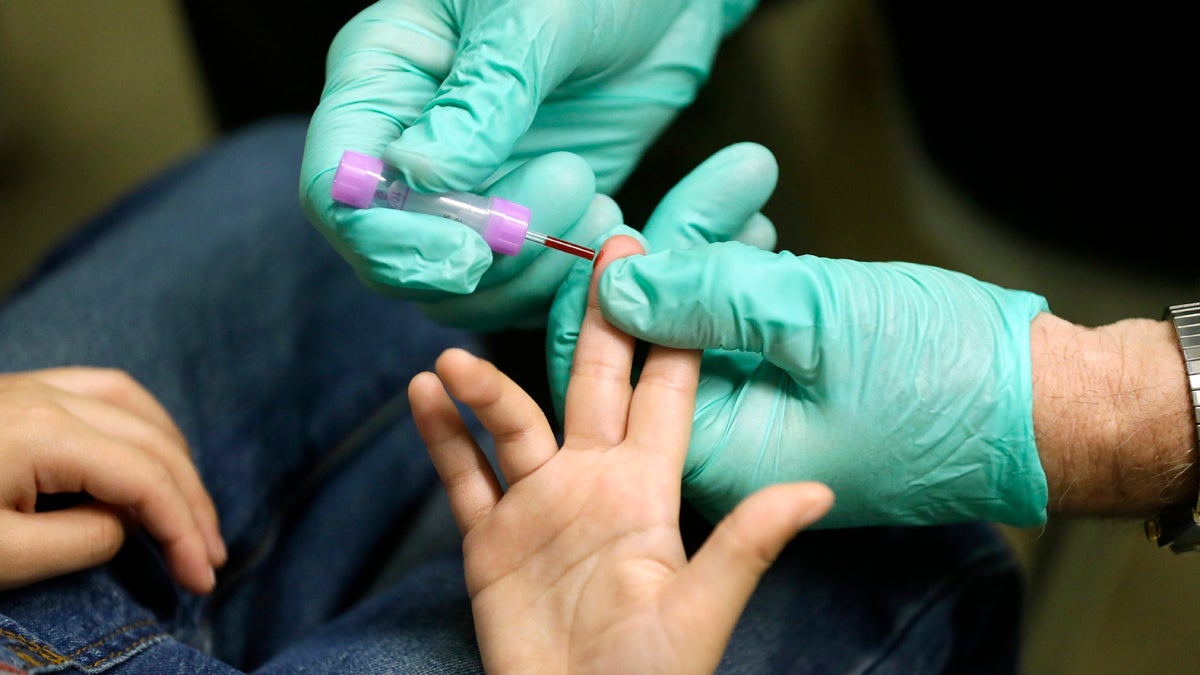Pa. considers testing all children for lead, like some other states do

A certified medical assistant draws a blood sample from a child in Flint
A look at other states shows that the approach might be a good idea, but it’s only a partial solution.
In Pennsylvania, only 26 percent of children are ever tested for lead in their blood between ages one and two. Governor Tom Wolf’s administration is hoping to change that. His office is reviewing legislation that would require doctors to test all children for lead at both of those ages.
A look at other states shows that the approach might be a good idea, but it’s only a partial solution to the state’s lead problem.
Why do it?
There are good reasons to require that all kids be tested for lead.
For one thing, lead poisoning is not a thing of the past. Lead lingers in old homes, in pipes, dust and chipping paint. That’s especially true in states with old homes — like Pennsylvania, where about 70 percent of homes were built before the federal ban on lead paint in the late 1970s. That lead is a health hazard, especially for young children. It can cause them lifelong learning disabilities and drops in IQ, even in small doses.
Also, lead exposure is widespread.
Take a look, for example, at Maryland. Many children in the state are never tested for lead. In 2014, only about 21 percent of the state’s children under age six were tested.
The reason: physicians in Maryland are only required to test a child for lead poisoning under certain circumstances. One of those circumstances: if a child lives in an area defined as “high-risk” for lead exposure.
But state data show that kids are exposed to lead everywhere in the state, not just in certain counties, says Dr. Clifford S. Mitchell, head of the environmental health bureau at the Maryland Department of Health and Mental Hygiene. Indeed, every county in the state has reported cases of children with elevated blood lead levels, he says.
You see a similar problem in Pennsylvania. Dr. Loren Robinson, deputy secretary for health promotion and disease prevention at the Department of Health, says there are old homes — many with remnants of lead paint — all around the state, not just in big cities. “It’s not just our big cities at risk,” Robinson said. “We’ve got Altoona. We’ve got Bethlehem. We’ve got Scranton. We’ve got all these smaller cities that still have older housing stock.”
In Maryland (and in Pennsylvania) doctors are also required to test children for lead if their families receive Medicaid benefits. That means a lot of children from low-income families are being tested.
But lead exposure isn’t limited to a particular income bracket; it can happen when any family remodels an old home, for instance, even if it’s an expensive one.
For these reasons, among others, the Maryland DOH thinks “it’s quite likely that we are missing some lead exposure,” said Mitchell.
That’s why the state is changing its rules. The DOH is finalizing regulations that will require lead testing for all children at one and two. “Our thinking is that the only way to really be sure that we have a good sense of where lead exposure is occurring is to try to test as many kids as we can,” Mitchell said.
The hope is that testing these children will allow the state to intervene sooner when they have elevated lead levels.
Policy vs. practice
Passing a law or a rule that requires all children be tested for lead is a start. But just because there’s a requirement doesn’t mean all kids will actually be tested.
In 1992, Rhode Island passed a law requiring children to have blood tests for lead twice before they turn three years old.
But only about 54 percent of children in the state are actually tested twice by that age, says Joseph Wendelken, public information officer at the Rhode Island Department of Health.
“Sometimes there are obstacles on the family side that prevent both tests from happening,” Wendelken said. One example: maybe a family has to go to a lab far away from home and doesn’t access to a car or public transportation.
The state is counseling health care providers and families to try to increase testing rates.
Since the law was passed, the percentage of children with elevated blood lead levels has declined, Wendelken said. The drop could be attributed to a few things, so it’s hard to say definitely that the lead testing requirement played a big role. But he says the regulation has been a good thing for the state. “Putting a regulation like this in place is a way of ensuring that all children, no matter what zip code they come from, are receiving the same careful look.”
A safety net
Public health experts say testing should function as a safety net, but that the main focus should be on getting lead out of the environment. That’s because scientists believe some of the health effects of lead on children are permanent.
As a result, the Centers for Disease Control and Prevention supports primary prevention, “a strategy that emphasizes the prevention of lead exposure, rather than a response to exposure after it has taken place,” according to its 2012 guidelines. The approach requires that the government do something to ensure that children don’t live in homes with lead hazards.
Making that happen could require tighter lead laws for landlords, a change in the way local agencies test water for lead, and increased funding to educate residents.
Governor Tom Wolf’s press office didn’t say when the new lead testing legislation would be introduced.
WHYY is your source for fact-based, in-depth journalism and information. As a nonprofit organization, we rely on financial support from readers like you. Please give today.


